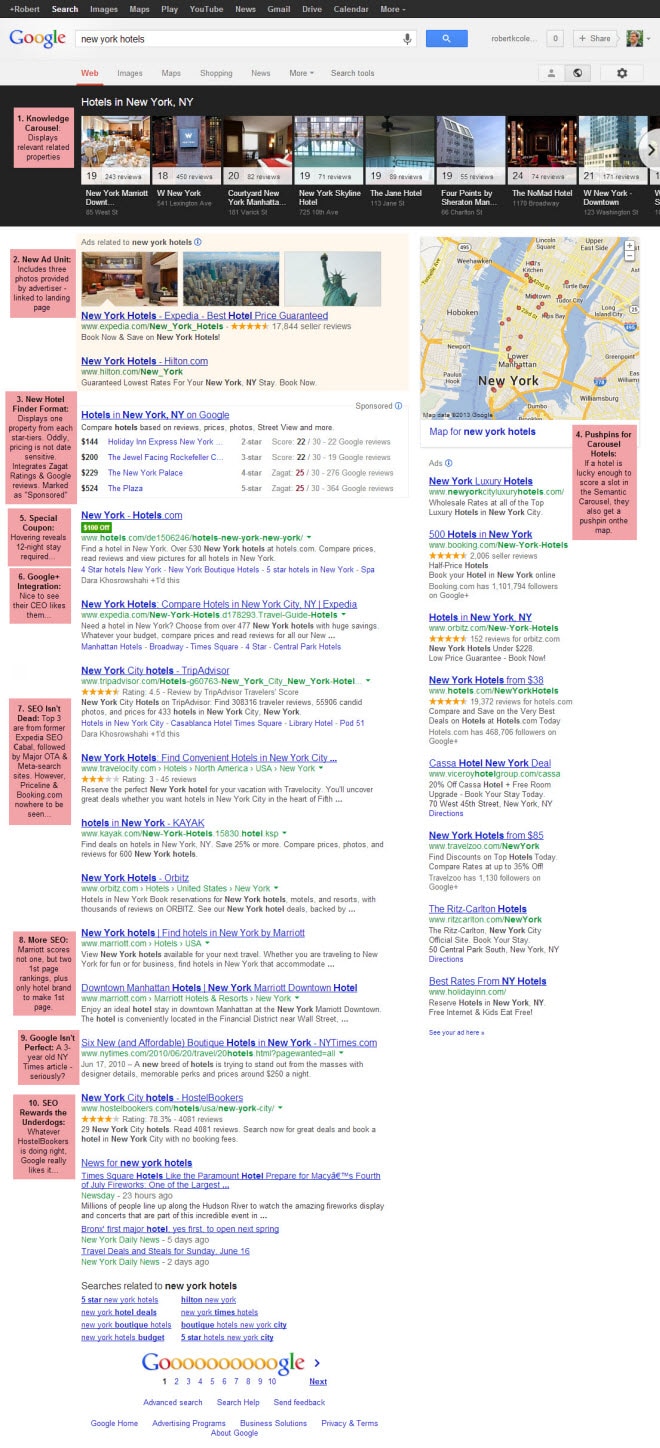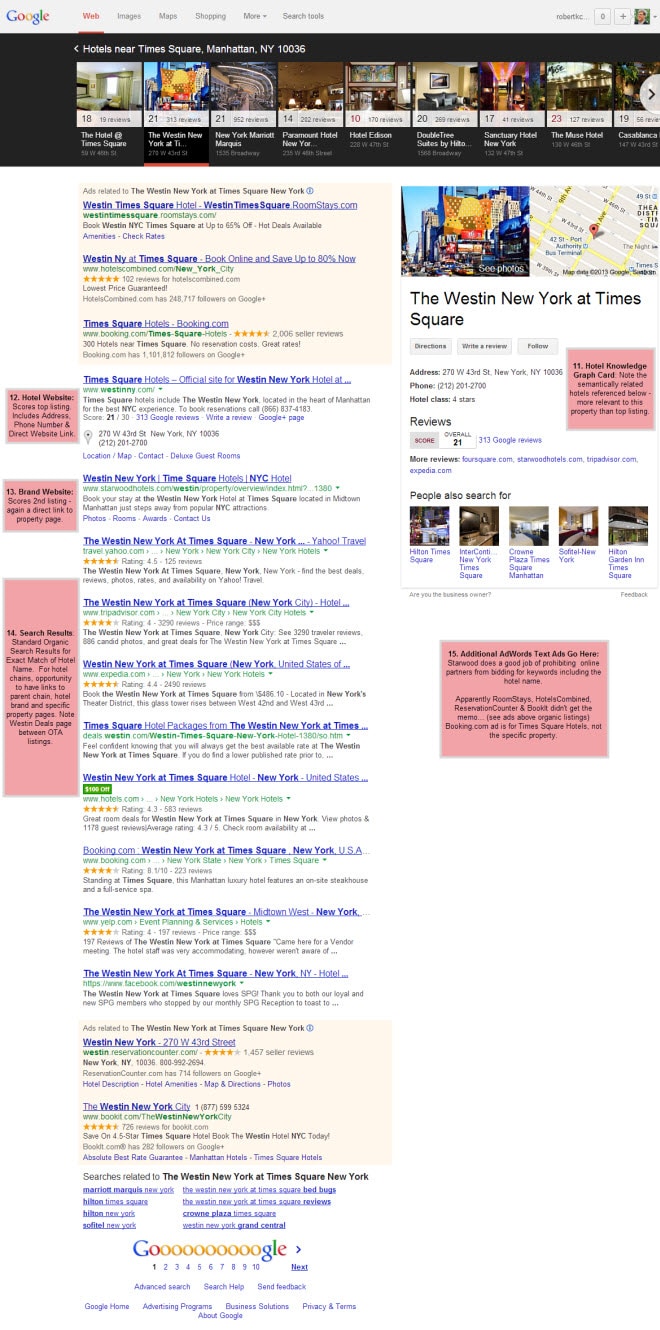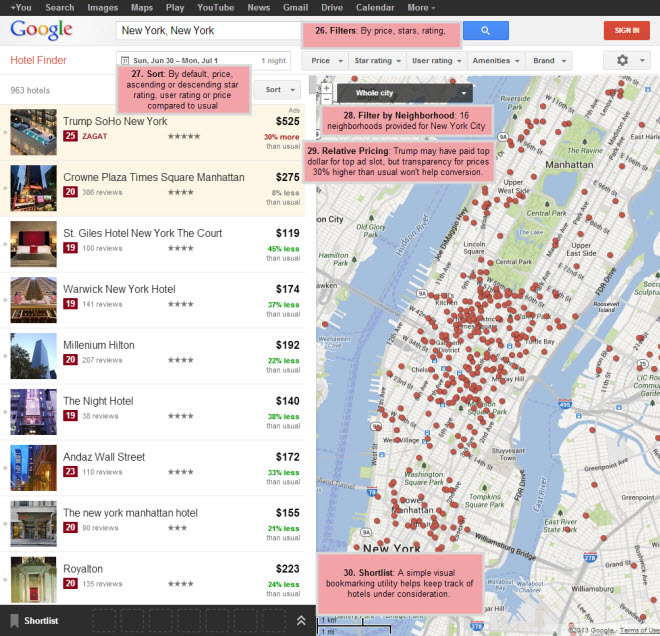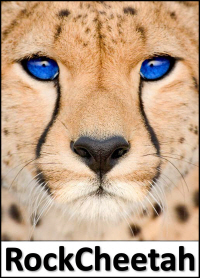Google scares Online Travel Agencies – but OTAs spend billions on Google-related ads & source a considerable portion of their traffic from Google. Google scares Hoteliers – but hoteliers love the prospect of sourcing traffic directly from Google’s Hotel Finder at a lower cost than the OTAs. Google scares travel meta-search sites – OK, maybe that represents a legitimate reason for concern…

Google updated its Google+ Local search processes and moved hotel search a good step forward. Hoteliers are going to like the changes and they shouldn’t piss off the OTAs too much either.
Image Credit: Michael Salerno cc|flickr
Consumers and Advertisers love Google. When it comes to searching for hotels, the 2012 Google/Ipsos study revealed 96% of leisure travelers started their hotel planning with search. There is not a publicly available statistic for Google’s share of hotel searches, but their overall search share is holding steady at 66.7%. If love could be expressed by browser behavior, this might be confused as adulation.
Google also commands 33.2% of the global $117 billion online ad spend. – up from 31.5% in 2012 according to eMarketer. As a point of reference, Facebook is in second place, with a 5% share. In mobile, they are even more dominant, with a 56% share, also up from 52.4% in 2012. While that may not reflect emotional love, it certainly reflects financial infatuation.
The challenge for Google is to make these various constituencies, often with diametrically opposed objectives, in a word, happy. Consumers want immediate answers to their queries – with the most relevant information prioritized for easy access. When it comes to mobile, they want enough information to make an informed decision without browsing through multiple pages and sites.
Advertisers want a return on their investment by converting search traffic into site traffic.
More specifically, OTAs want an opportunity to provide comparison shopping for all the OTA loyal or hotel brand agnostic travelers. Hotels and hotel brands want to cost-effectively attract brand loyal customers, as well as any that may merely have any degree of brand awareness.
Smaller and independent hotels that may not have the budget or expertise to execute Pay per click search campaigns simply want organic search to work effectively to be found based on merit – without the deck being stacked against them by larger and better funded competitors.
In the process of satisfying these groups, Google must also attempt to avoid accusations of being evil, while capturing a profit margin reflecting their ability to collectively add value to the overall process.
In many regards, with its latest update of its desktop local search results, Google has successfully maneuvered the treacherous waters of the online travel industry. While it is doubtful all parties will be ecstatic regarding the changes, ground for righteous outrage are largely unfounded.
First and foremost, Google has improved the hotel search experience for travelers, without disenfranchising any of the special interests inhabiting the ecosystem. Happy users mean more traffic, hopefully better conversion, and sales growth from the channel.
What follows is a breakdown of the improvements – many that were introduced in either Google Local searches and/or tablet search functionality launched six months ago.
In order to provide a complete perspective on the significance of these changes, it is also important to observe how the new formats integrate with hotel-specific searches and the Google+ Local pages.
There are 25 relatively new or newly integrated items that should be taken into consideration. These are also highlighted because most hotels currently feature the dreaded “Is this your business? Manage this page” prompt on its sparsely populated Google+ Local page.
Some online distribution, ad agency and corporate personnel desperately needs a refresher course on the basics of online hotel distribution – especially a reminder to keep updated on the changes impacting search and social platforms.
Google+ is much more than a simple social network – it provides context and validated relationships between pieces of information. It is the core of Google’s semantic web and related social initiatives.
Below are annotated screenshots of the new desktop destination search, specific property search and hotel Google+ Local pages.
First, this is what is now returned when “New York Hotels” is searched. The top 10 points that stand out are highlighted.

Google changes the look of its hotel search results, making them smarter and a bit more supplier friendly. Even though Online Travel Agencies continue to dominate the first page of organic search results.
- Google applies its Knowledge Graph image carousel to display related properties that are most relevant to the search term utilizing semantic technologies. The Zagat rating and number of reviews are included. Would guess the review count would eventually be replaced by a rate if a traveler has previously entered dates into the Hotel Finder (but that is pure conjecture.)
- A new expanded advertising unit is presented – the Expedia ad not only features top position above the organic results, but also includes three photos. Considering this is new, one can assume the relevance of the photos will be improve considerably over time.
- Google Hotel Finder is now clearly marked as sponsored content. While it does push down organic listings, only one property example is provided for 2- through 5-star properties respectively. A non-date-specific price is posted, as well as the Zagat rating and number of reviews. This much less aggressive and less real-estate intensive approach to product search should help to temper several Fairsearch.org complaints and apease many congressional concerns.
- The map features red dots for each of the hotels featured in the image carousel. Hovering over the dot pops up the hotel name with a link to its Google+ Local page.
- This is an example of an organic search listing that features a coupon. Hovering reveals the details of the coupon. In this case, a $100 rebate is available for a 12-night stay – not a very realistic offer. Again, being relatively new, Hotels.com will undoubtedly get more clever in determining what will work best to incent clicks and conversion.
- If the user is logged into their Google+ account and someone in their circles +1’s (that’s the equivalent to a Like to all the Facebook users) a web page, a notification is added below the organic search listing.
- SEO is still important. Obviously large OTAs have an advantage for general searches, but individual hotels still have an opportunity with more long-tail search terms. Booking.com and Priceline ere auspicious in their absense from the results.
- Marriott managed to score two listings – the only ones in the top 10 populated by a hotel supplier for this search) with its New York Hotels page and the Marriott Downtown property page.
- Why is a 3 year old article about new boutique hotels included int he results? Only the Search Gods know… Probably some algorithm trying to inject relevant some news from a reputable site. Thinking the date published might be a good factor to add in that algorithm…
- Again, for some reason, Google feels hostel searches are relevant for New York and HostelBookers must be doing some great SEO tricks to grab the last slot on page one.
- A Hotel Knowledge Graph card is provided for the hotel that includes all key information like photos, map/direction and Zagat/review links, plus address ad telephone and hotel class. It also uses the Knowledge Graph to provide image links to five additional hotels considered similar based on semantic search technology.
- The hotel property website should normally be displayed as the top organic search result listing – with its corresponding direct link to the property website.
- The hotel brand website should normally be displayed as the second organic listing – again, with a direct link to the appropriate hotel page on the brand website.
- The remaining organic search results should be similar to an organic search – the order should not be impacted by any advertising activity.
- If sufficient bidding volume exists, additional paid AdWords listings will appear in the right column.
- Links at the top of the page are provided to hotel-sourced post, photo and video content. Very few hotels are leveraging this capability.
- The larger image provides a compelling positioning opportunity. If the hotel does not provide a photo, the image defaults to a street-format map of the neighborhood. And a lost opportunity
- The Google+ +1’s are auspiciously displayed. Hint, hint…
- Photos sourced from the community are easily accessible for review – even more so than the images provided by the hotel.
- Maps are fully integrated as they serve as the foundation of the Local platform
- Google Price Ads are prominently displayed
- If the hotel has merged its Google+ Local and Google+ Business listings, a link to the Business Listing is provided.
- Zagat rating and reviews, as well as key features are provided.
- Even more Google+ integration with those including the property in circles listed – with corresponding links to their Google+ profiles.
- Food & beverage outlets also get links to their Google+ pages – another aspect that goes largely overlooked by most hotels.
- The results list may be filtered by price, stars, rating, amenities and major hotel brand
- Working in tandem with the filtering capability, the results may be filtered by star rating in ascending or descending order, the user rating, or the current price relative to its normal pricing.
- Pre-defined, polygon-based neighborhoods are provided to help better target specific areas. it is unclear why Google decided to use quadrilaterals, but they make them work, despite the obvious limitations.
- Relative pricing is a powerful capability as illustrated by an ad highlighting a price that is well out whack with the rest of the market.
- To simplify comparisons, users are able to bookmark properties by adding them to a shortlist for quick reference. Another powerful tool that empowers the consumer to make better informed decisions.
The greatest benefit of the Knowledge Photo Carousel is that it provides one click searches for each of the featured properties. The original list of Knowledge Graph Image results are maintained as properties are selected and searched without entering the Google Hotel Finder tool.
Next is a screenshot of the results of a single-click property search (this one was from a booking that queried Times Square Hotels.) Five key points standout:

Single click searches for semantically similar hotels are available from the carousel. A Knowledge Graph card for the property is also provided next to full organic search listings.
The Knowledge Graph includes a price for a default date, but clicking on the price opens a Google Price Ad widget that allows dates to be entered, with updated pricing immediately displaying in the widget.
While none of the links on the Knowledge Graph card point to the property website, with its positioning on a page where the hotel is the top organic search result, concerns of Google attempting to hijack all search traffic to its owned page content are largely appeased.
Following a link to the hotel’s Google+ Local page provides a graphic example of the gap that exists between Google’s enhanced capabilities and hotel industry adoption. Very few hotels have claimed, let alone populated their Google+ Local page with updated content.
Even for the few that have made the updates, even fewer have merged their self-managed Google+ Business listings with the Google+ Local pages predominantly managed by Google. One can only assume that the merging of these pages will provide for better seamless navigation across the different content sources in the future.
Below is an example of a merged page that has updated to the now now super-large header image. One can only hope hoteliers will use this space to show real humans enjoying the hotel as opposed to static architectural shots. Included are ten more points to consider.

Google’s new Google+ Local pages feature larger photos, the ability to merge with Google+ Business pages and lots of social & review content links.
With the greater integration of Google+ Local content into organic search processes, the importance of maintaining Google+ profiles and building out pages completely has increased significantly.
Finally, the last piece of integration is the Google Hotel Finder. This too shares the main attributes of the organic search and Google+ Local pages – Zagat ratings, reviews and pricing – all framed by the location.

Google Hotel Finder integrates with the new Google+ Local search functionality by aligning Zagat ratings, number of reviews, neighborhood and star ratings. Look for more integration in the future.
In total, Google has made great strides to integrate its own search, mapping, ratings and social platform with interactive pricing, and user generated content. The most integral part may very well be the emergence of the Semantic Web – providing contextual relationships between hotels based on, honestly, whatever consumers – through their behavior – and the algorithm, deem relevant.
Google has smartly supported the needs of the hoteliers and provided OTAs with additional opportunities to convert sales while making the hotel search and planning processes more efficient and streamlined for the user.
It is a large step forward that strongly supports the hotel and travel ecosystem – except perhaps, for competitive metasearch platforms. Google is finally beginning to demonstrate that it can deploy technology to create a sum that is greater than its component parts.




